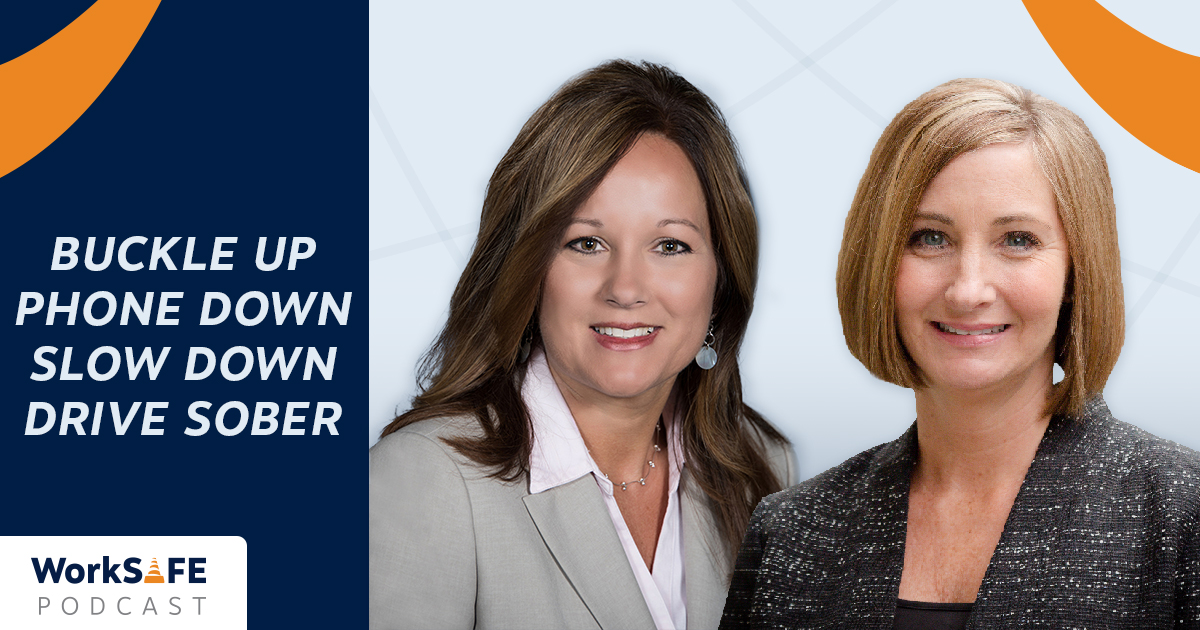For Media Inquiries
Contact Revee White, Director of Marketing and Communications at rwhite1@mem-ins.com or 573.499.4190.
COVID-19 has changed the way most Americans travel this year. People are driving far less than they have in recent years. However, fewer cars on the road don’t prevent crashes. According to the Missouri Department of Transportation (MoDOT), traffic fatalities rose by 12%.
Vehicle crashes are still the number one way to die on the job. Why has Missouri seen such an increase in accidents, when there are fewer cars on the road than ever before? How can employers encourage their employees to practice safe driving behaviors?
On this episode of the WorkSAFE podcast, we are joined by Nicole Hood. She is a State Highway Safety and Traffic Engineer at MoDOT. Hood has 24 years of experience. She leads road safety programs and safety initiatives.

First, we’ll talk about why the traffic fatality rate is going up. Then, we’ll talk about what causes people to practice unsafe driving behaviors. Finally, we’ll share four tips to keep your employees, family, and other drivers safe on the road.
Listen to this episode on the WorkSAFE Podcast, or read the show notes below.
Unexpected problems: fewer cars, but more fatalities
Many people might be confused to hear about increased traffic fatalities in 2020. There are fewer cars on the road. Commuters run into less morning and evening traffic. As a result, some people are even receiving lower car insurance rates.
“I don’t know if a lot of Missourians realize the problems we’re dealing with,” Hood said. MoDOT discovered that even if you take half of all drivers off the road, there will still be accidents. “At the beginning of the pandemic I was very hopeful, and I thought for sure that the less traffic on our roads would result in less fatalities for Missouri. But that’s definitely not been the case.”
For Hood, these new statistics reveal that making good choices while driving is more important than ever.
Why are fatalities going up?
Unsafe driving behaviors are a primary cause of traffic accidents. Many people try to do many things at once – eat, use a GPS or smartphone, soothe an upset child. COVID-19 has added an extra layer of stress to many lives. Schedules change and rotate. As a result, many people are often in a hurry, trying to adjust to a life that looks much different than it did a year ago.
High speeds cost lives
Empty roads give many drivers a false sense of security. It’s much easier to go faster when there aren’t any cars around. Hood pointed out that you’re much more likely to encounter a driver going 100 miles per hour (MPH) now than before the pandemic. Speeding is a big driver of traffic accidents.
MoDOT traffic officers clocked alarmingly high speeds during one weekend this year, issuing over 600 speeding tickets. Nearly one-third were going 20 miles per hour over the speed limit – or more.

Work zone employees at risk
Employees who work beside interstates and highways are also at increased risk. In 2020, 22 people have lost their lives in work zones. Speeding and distracted driving are often the cause. “We’ve seen more lives lost in work zones this year than we’ve seen since 2004,” Hood mentioned. Slower speed limits and orange cones often mark work zones. But to protect roadside workers, drivers must follow the posted warnings.
Unbuckled drivers face extra dangers
MoDOT has seen a notable increase in unbuckled fatalities. Pandemic travelers are not buckling up. During an annual survey, MoDOT observed that although the Missouri population grew, seat belt usage was down. Hood notes that drivers who ignore stay at home orders tend to be rule-breakers. They are also less likely to wear their seatbelts.
Commercial drivers at risk
Demand for essential supplies means more commercial drivers on the road. These drivers are often under tight deadlines. Many people assume they are the cause of traffic collisions. However, Hood sees that passenger cars are more often at fault. Commercial drivers must watch for – and respond to – reckless drivers.
What do employers need to know about road conditions today?
While COVID-19 has reduced the amount of traffic on the road, safety is still a concern. Drivers are engaging in riskier behaviors. Fewer cars on the road don’t prevent crashes.
Hood reminds employers that it is important to teach traffic safety and defensive driving to their employees. Encourage employees to make safe choices. Train them to develop safer habits. Employees can change the trends and make roadways safer.

4 tips to prevent crashes during COVID-19
There are 4 tips Hood shares to help every employer – and employee – prevent crashes. She encourages people to visit Save MO Lives, a website created by the Missouri Coalition for Roadway Safety (MCRS). The organization dedicates its time to saving the lives of Missouri residents on the road.
Through an initiative called Show-Me Zero, MCRS shares four important tips. These tips are essential to eliminating fatalities and serious injuries on Missouri roadways. Hood shared that these steps can help anyone – and especially employees – stay safe on the road.
1. Buckle up
Seat belts are free and already installed in most cars. They are also the greatest way to increase your chances of surviving a crash. In the event of a crash, a seat belt can prevent you from being ejected from the vehicle. It also helps you stay in control of the car. “We’ve estimated that if every single person in Missouri used their seat belts, about 240 lives would be saved each year,” Hood added.
Teach employees about the importance of using a seat belt while on the job. Then put a seat belt policy in place. If employees sign a safety policy, then they are held accountable for using a seat belt every time they get behind the wheel.
2. Phone down
Phones tempt many drivers while they are behind the wheel. But is answering a text or changing your playlist worth risking the lives of yourselves and others on the road? Distracted driving is often considered a problem that only affects teenagers. However, Hood disagrees. Over 87% of distracted drivers involved in a fatal crash were over the age of 21. And more than half of the time, someone other than the distracted driver was killed.
Distracted driving affects employees in all industries. There are three different types of distractions – visual, manual, and cognitive. Using a smartphone causes all three to happen at the same time. Focusing while driving is the key to prevent crashes. Implement a policy to prevent employees from using a cell phone while driving. Then, teach them safe driving behaviors. These habits include:
- Pre-programming favorite music stations
- Entering addresses into a GPS before leaving
- Putting smartphone out of sight
- Avoiding eating or drinking

3. Slow down
In 2019, there were 310 speed-related fatalities in Missouri. Fast speeds increase the severity of crashes. When a vehicle is going too fast, it takes longer to brake. It is also easier to lose control of the wheel. Avoiding other cars or objects in the road is increasingly difficult at high speeds.
Encourage your employees to obey posted speed limits. Share the importance of planning ahead. If employees are headed to an important meeting or conference, then they should allow enough time to travel there safely.
4. Drive sober
Impaired driving poses major risks to those behind the wheel – and those in the car with them. 184 people were killed in crashes involving an impaired driver in 2019. According to Hood, impaired driving can involve the use of:
- Drugs
- Alcohol
- Prescription medications
- Medical marijuana
Most people assume impaired driving involves drugs or alcohol. And while this is true, driving for hours without sleeping also creates impaired drivers, too. Physical impairments, like drowsy driving or poor vision, create dangerous situations.
Consider adding a drug and alcohol policy to your safety program. Educate employees about the warning signs of an impaired driver, like swerving, driving very slowly, and braking erratically. Watching carefully for other unsafe drivers can prevent crashes. Caution them to stay at a safe distance and alert the police if there is an unsafe driver on the road.
Safe driving is for everyone. During Covid-19, it reduces contact with strangers, allows families to travel together, and helps maintain social distance. But to create safer roads for everyone and prevent crashes, drivers must develop safe habits. The most effective ways to influence your employees’ driving behaviors are to provide resources and have them sign written policies.
For more resources on safe driving, visit our Resource Library. Then, discover our top tips for driving safely during the winter in this episode of the WorkSAFE podcast.